Читать книгу Newspaper Articles - Edward Sylvester Sorenson - Страница 10
На сайте Литреса книга снята с продажи.
ОглавлениеThe Type Australian
His Characteristics And Environment
Table of Contents
The Northern Territory Times and Gazette (Darwin)
Friday 5 December 1902
Table of Contents
The big cumbrous tobacco pouches made by saddlers, and once extensively carried on the belt as a “hold-all” for tobacco, matches, knife and money, are becoming obsolete, And its place is taken by a small watch pouch. The pipe nowadays, if not pocketed, is thrust under the belt, or under the hat band. Some effect a peculiar fashion in belts made of gohanna skins, carpet-snake skins, and other skins and hides neatly plaited; while wrist-straps are often plaited eel-skins. Caps are made from the skins of swans, platypus, squirrels and native cats. Love of novelty and originality is one of the strong points in the Bushman’s character.
His characteristic call is the world famed coo-ee. Webster’s Dictionary refers to it as being of imitative origin: “a peculiar whistling sound made by the Australian aborigines as a call or signal.” This is not quite correct, though I believe the source is genuine. When gins are calling to one another at a distance they “yabber” rapidly, the voice being raised to a long shrill cry with the last word of each phrase or sentence, the terminal frequently sounding like wa-a-y. This habit, I believe, is peculiar to the majority of tribes throughout the Continent and undoubtedly originated the Bushman’s now famous coo-ee. Strictly speaking, coo-ee is feminine, that is, it is the call of the Bush-woman; the male call is more like ca-a-w-whey—the first syllable lingering and comparatively low, the second loud, sharp and abrupt, which is the secret of its far reaching quality.
The “smoke-o” is an honoured and long established custom. Nothing is more suggestive of ease and comfort than the evening “smoke-o,” when the day’s work is done and supper is over, and dad sits on his favourite block in front of the “humpy” in summer, and before a blazing log-fire in winter, meditatively puffing at his pipe. That is the time he becomes reminiscent, and entertains all and sundry with his quaintly-embellished experiences of “Old Times.” In the shearing shed “smoke-o” is indulged once between breakfast and dinner, and twice between dinner and “knock off.” At weekly work “smoke o” occurs pretty well every hour; but at piece-work it doesn’t happen along nearly so often.
The Bushman’s nights are spent in card-playing, reading, yarning, patching, whip-making, soling and heeling old boots, cutting out pipes, etc.; and occasionally, in the case of a settler, he will go out on the flat with his gun, a bare-legged boy following with the ammunition-bag, to shoot a ‘possum or two for the dogs, or merely for pastime. Many in the settled districts make a big profit by shooting and trapping for skins.
It is notorious that the settler is as a rule a stickler for home. Many a one of middle-age has never seen a train or a ship; and there are old men who have never looked upon the sea. Though there are roving spirits among them, the average, even when in search of work, keep within certain limits like their native crows. When they go droving, on a journey of several hundred miles, they make straight back for their old haunts on being paid-off. At the same time, there may be nothing to call them back but familiar stations where they have worked, or a few mates they have worked with; no fixed home and no kindred, and never a pair of bright eyes to induce them to “turn their grays once more to the south.”
Some of the numerous bush inventions are hard to beat: the water bag, the salvation of thousands; the buckleless bridle of plaited hide, the buckleless hobble-strap, the “fork” for straining wire, and the “over-lander.” The latter is a pack-saddle made with crossed sticks, hide, wire and bag, stuffed with grass. It is light, serviceable, and quickly made.
Though a resourceful person in the main, the Bushman’s home doesn’t show to advantage, except from a picturesque point of view. It is built on the assumption that “it will do in our time,” and the principal object aimed at is to make it keep out rain. In other respects it permits one to take a perspective view of the country without going outside. The usual humpy is walled with rough slabs, and roofed with bark, secured to battens with strands of green-hide, and held down with poles, the tops being pegged together over the apex, and having a transverse pole across the bottoms. A dog-leg fence staggering down to the creek on one side, and wobbling up a gum-ridge on the other, is a congenial adjunct. Fowls feed around—timid, athletic fowls, trained in the pursuit of grass-hoppers; a clothes-line stretched between two trees, a few stumps here and there; a lot of dead-white trees, littering the ground with dead limbs and bark, at the back; a man ploughing or splitting in the distance, and a general boundary of ever-lasting gums.
Slabs, bark, green hide and dog-leg fences were the leading features of the Old Bush Home, and still are in many places; but in settled districts shingles have taken the place of bark, and two railed fences succeed the old dog-leg. Nowadays, fencing wire is the article of general utility, filling a thousand wants ranging down to boot laces. Neat cottages, too, with iron roofs, gleam every where; and carts and buggies rattle in the wake of the old slide. Yet I doubt if the man in the modern cottage it as happy as his progenitor in the old bark hut, whose saddle reposed on a peg in one corner, his bag-bunk in another; who stepped out on a cow-hide mat, stood his dampers on a packing case, and slung his billy on a wire hooked to a blackened trace chain.
